The food in Thailand is one of our absolute highlights of every trip. Thai cuisine is incredibly diverse – sometimes spicy, sometimes sweet, sometimes hot, but always full of flavor. After several months in Thailand, we’ve found our absolute favorite dishes. Here are our 10 favorite Thai dishes that you should definitely try on your trip.
- Why is the food in Thailand so delicious?
- What does Thai cuisine consist of?
- Where is the best place to eat in Thailand?
- Important terms for the menu
- Our 10 favorite Thai dishes
- Street food in Thailand – what to look out for?
- How spicy is “spicy” really?
- Typical drinks in Thailand
- Is there Western food?
- How much does food cost in Thailand?
- Thai dishes for home
Why is the food in Thailand so delicious?
Why is the food in Thailand so delicious? It’s simple: everything that tastes good comes together here. Sweet, sour, salty, and spicy – always perfectly balanced. Fresh herbs, crunchy vegetables, spicy curry pastes, coconut milk, lime, and, of course, chili are a must in every dish.
Everything is freshly picked from the market and (usually) prepared on the spot. And the best part: You can almost always tell us how you like it – less spicy, extra spicy, or extra crispy. This combination of fresh ingredients, strong flavors, and attention to detail makes Thai cuisine simply unbeatable for us.
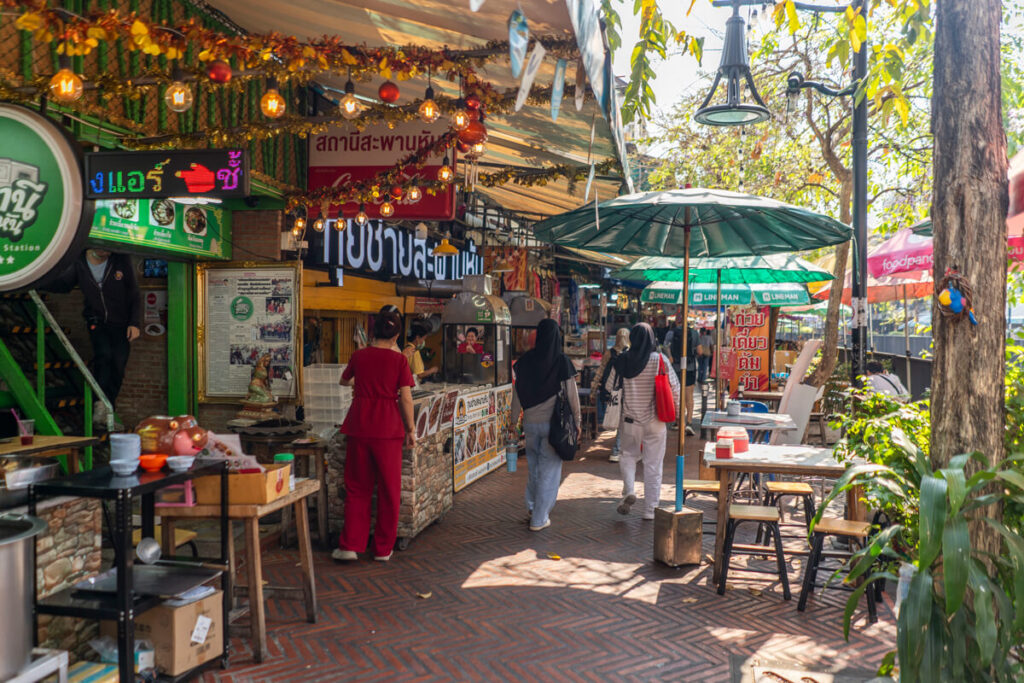
What does Thai cuisine consist of?
Thai cuisine relies on:
- Fresh herbs and spices: Lemongrass, Thai basil, coriander, kaffir lime leaves, galangal
- Curry pastes: Red, green, yellow, Massaman, and Panang – each with its own flavor
- Rice and noodles: In all variations – as a side dish, main ingredient, or fried
- Coconut milk: For curries, soups, and desserts
- Fish sauce and soy sauce: Important basic ingredients for the umami flavor
- Chili, lime, and sugar: For the perfect balance of hot, sour, and sweet
- Lots of vegetables: From crunchy beans and bell peppers to baby corn and mung bean sprouts.
The result? A cuisine that’s light, fresh, aromatic, and satisfying at the same time—and one you simply can never get enough of! We can assure you of that!
Where’s the best place to eat in Thailand?
The best place to eat is where the locals eat! Food stalls, small street stalls, and night markets are often the first choice—and that’s where you’ll find the most authentic, freshest, and tastiest food. And don’t worry: Even if it sometimes looks simple, the food is usually cooked super fresh. You can see what’s going into the pan and your food will arrive piping hot on your plate.
Our tip: The more locals sitting or queuing at a stall, the better! That’s the best sign of quality. If the stall is busy, you know that fresh food is being cooked there regularly. Small, local restaurants off the main tourist routes are also often a hit—and usually cheaper than fancy beach restaurants.
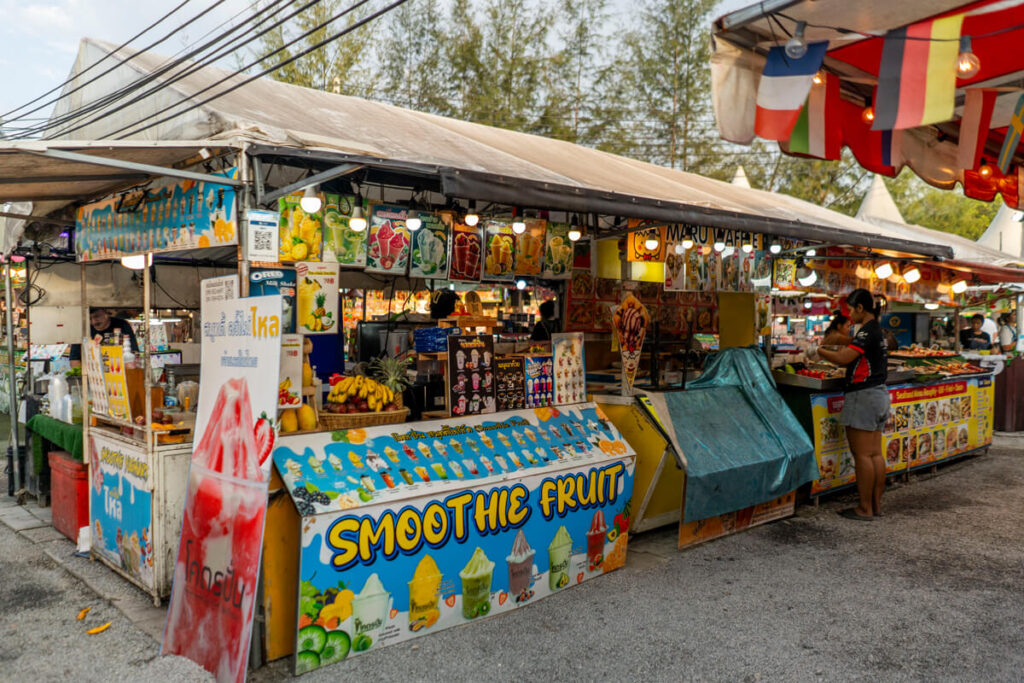
Important Terms for the Menu
So that you know what you are ordering, here are some practical vocabulary words to help you navigate the Thai menu:
- Pad – fried (e.g. Pad Thai = fried noodles)
- Khao – rice
- Kai Dao – fried egg (often as a topping)
- Moo – pork
- Gai – chicken
- Nuea – beef
- Goong – shrimp
- Talee – seafood
- Pak – vegetables (often water spinach or other green Vegetables)
It’s worth saving or screenshotting – it’s guaranteed to help you at the next street food stand!
Our 10 Favorite Thai Dishes
There are countless delicious dishes in Thailand. We’ve limited ourselves to our 10 most popular dishes so that this post doesn’t become a novel.
1. Pad Thai
The absolute classic and one of the most well-known dishes! Fried rice noodles with egg, tofu (vegetarian version) or chicken, crunchy vegetables, peanuts, and lime. Available almost everywhere – from food stalls to restaurants – and always tastes like vacation. Some serve the dish spicy, others mild. It’s best to say how you’d like it when you order. The most well-known variation is probably Pad Thai Chicken.
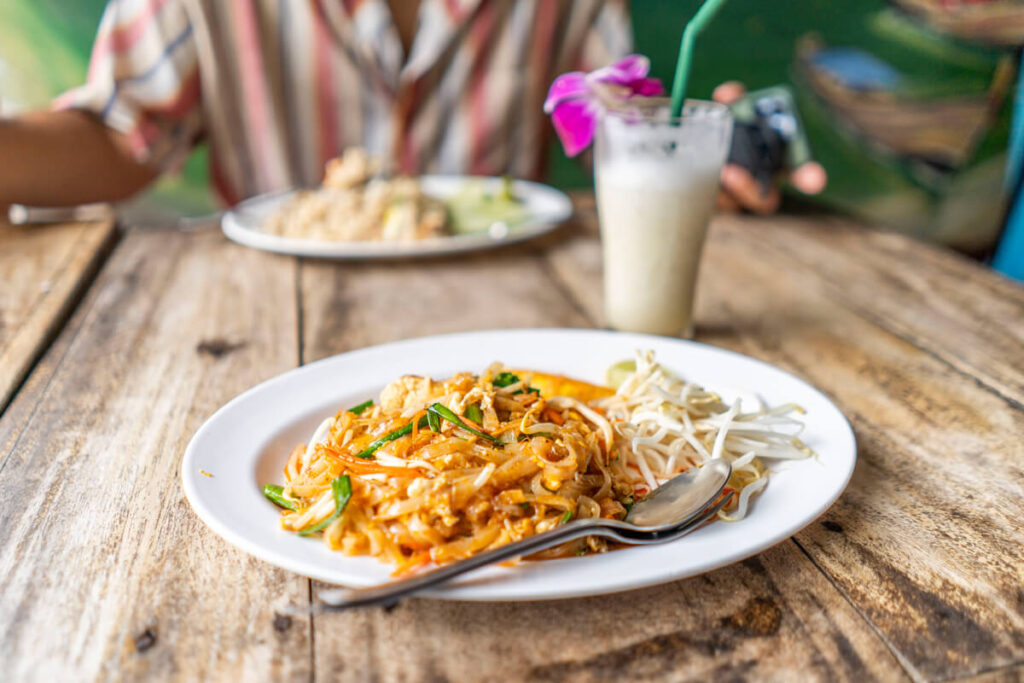
2. Massaman Curry
Red curry, yellow curry, green curry – we simply love curries! One of our absolute comfort foods, however, is Massamam Curry! A mild, slightly sweet curry with potatoes, peanuts, onions, and chicken or beef. Especially delicious with rice and perfect if you don’t like it too spicy. We could eat this dish every other day!
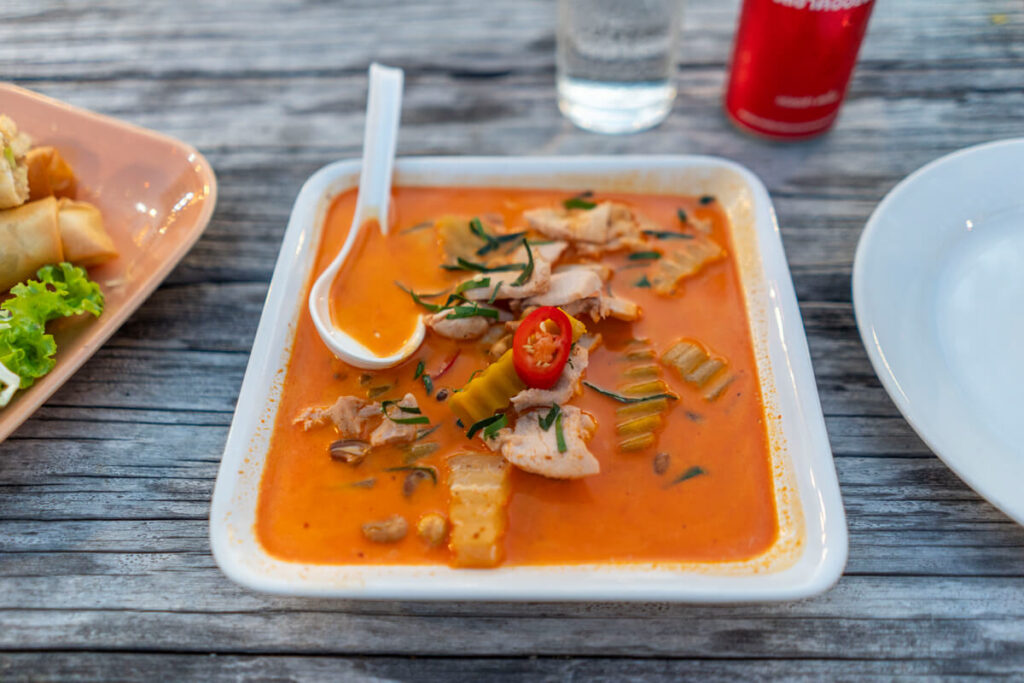
3. Mango Sticky Rice (Khao Niew Mamuang)
Sweet and simply unbeatable: sticky rice with creamy coconut milk, fresh, ripe mango, and a hint of sesame seeds on top. Best ordered fresh at night markets! We ate tons of it on our last trip. Mango Sticky Rice is simply the perfect snack for in between meals.
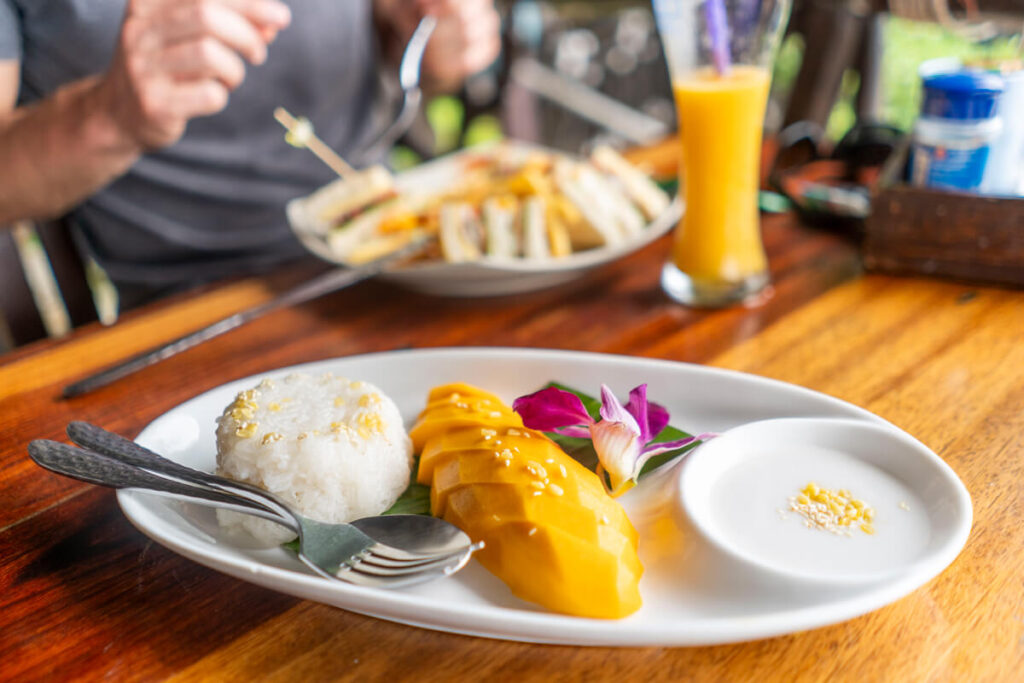
4. Khao Soi Soup
A traditional dish from Northern Thailand and simply legendary: creamy, spicy, and with a light curry note. Topped with crispy fried noodles, lime, pickled vegetables, and onions. Khao Soi is probably the most well-known soup, and there are many different variations – and they are all delicious! Classic with chicken or beef, but also great with tofu or vegetables.
Every food stall makes it a little differently – sometimes spicier, sometimes milder, sometimes more intense. Definitely a must if you’re traveling in Northern Thailand (e.g. Chiang Mai)! You can also get the soup in almost all other tourist areas these days.
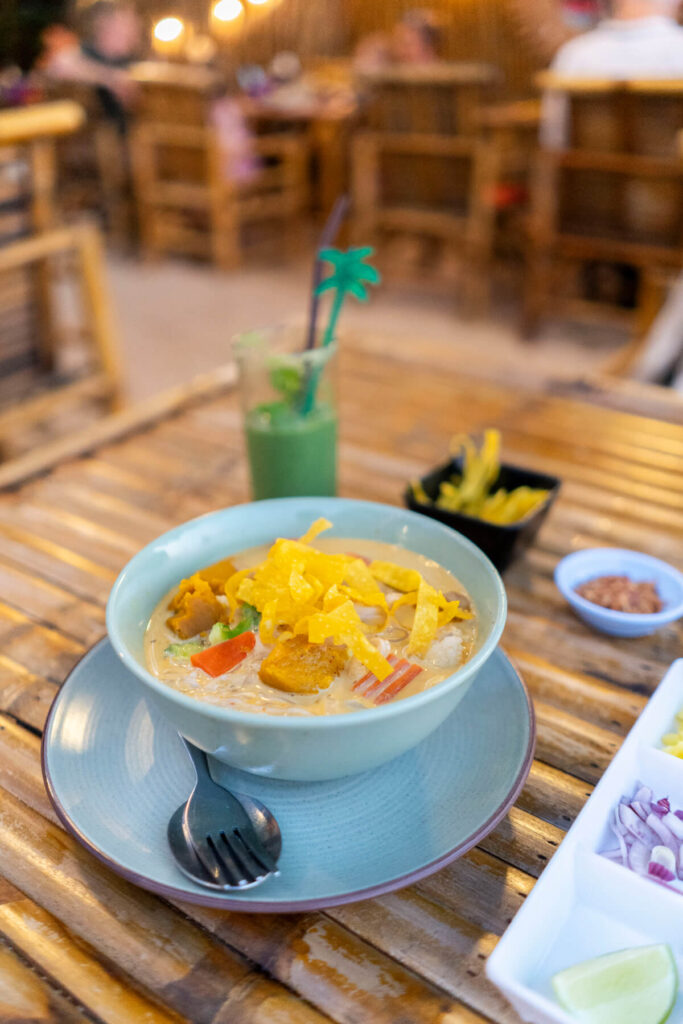
5. Panang Chicken
A slightly thicker, creamy curry with a hint of peanut and mild chili. With chicken and rice, it’s an absolute comfort food for us. You can also order the dish vegetarian, with shrimp, or tender meat.
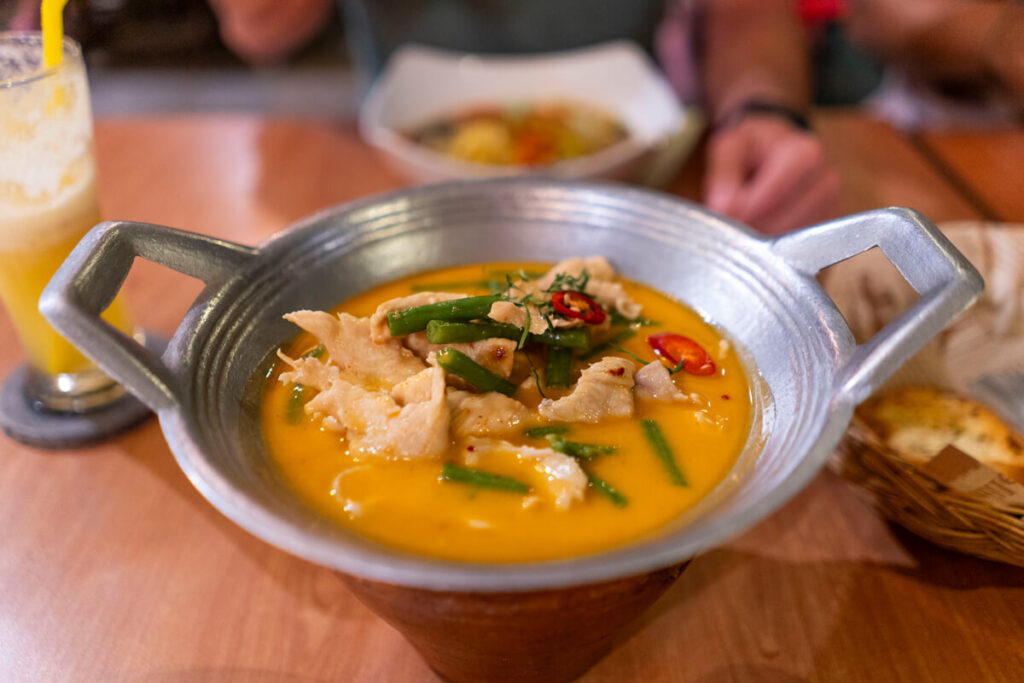
6. Fried Rice with Vegetables (Khao Pad Pak)
Simple but perfect – fried rice with crunchy vegetables, eggs, and sometimes a bit of tofu or chicken (Khao Pad). Always a hit, whether as a lunchtime snack or a quick dinner. You can get this dish at simple, small street stalls for 40–60 baht (approx. €1.50).
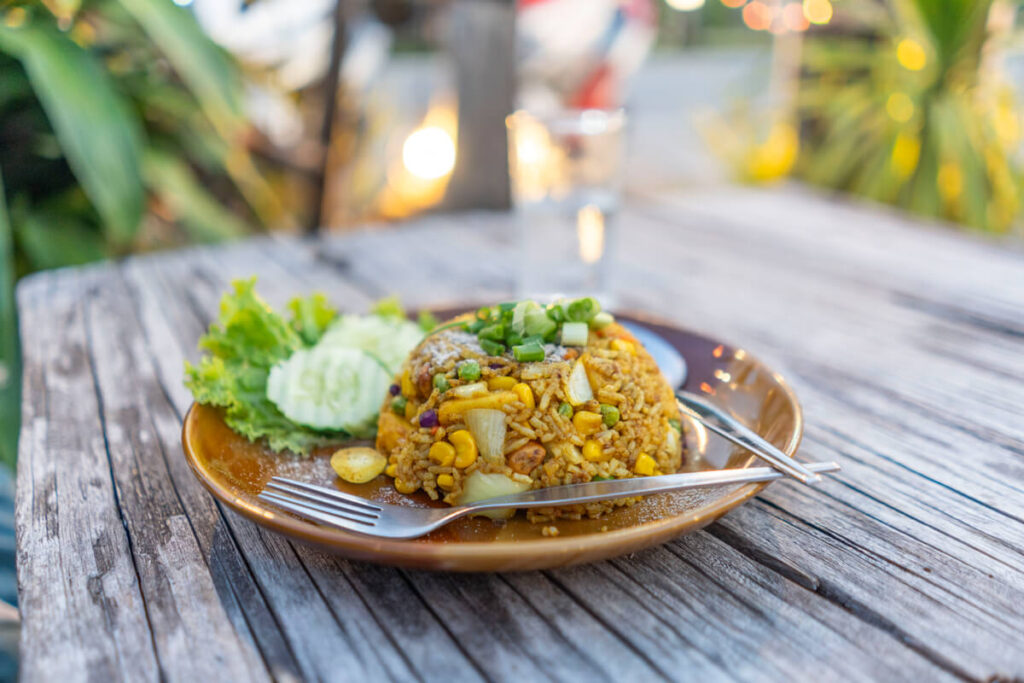
7. Omelette with Rice (Khai Jeow)
Thai omelette is fluffy, often seasoned with fish sauce and spring onions, and fried in hot oil. Served with rice and chili sauce – cheap, delicious, and filling. But be careful: The egg is usually very fatty, but tastes really great!
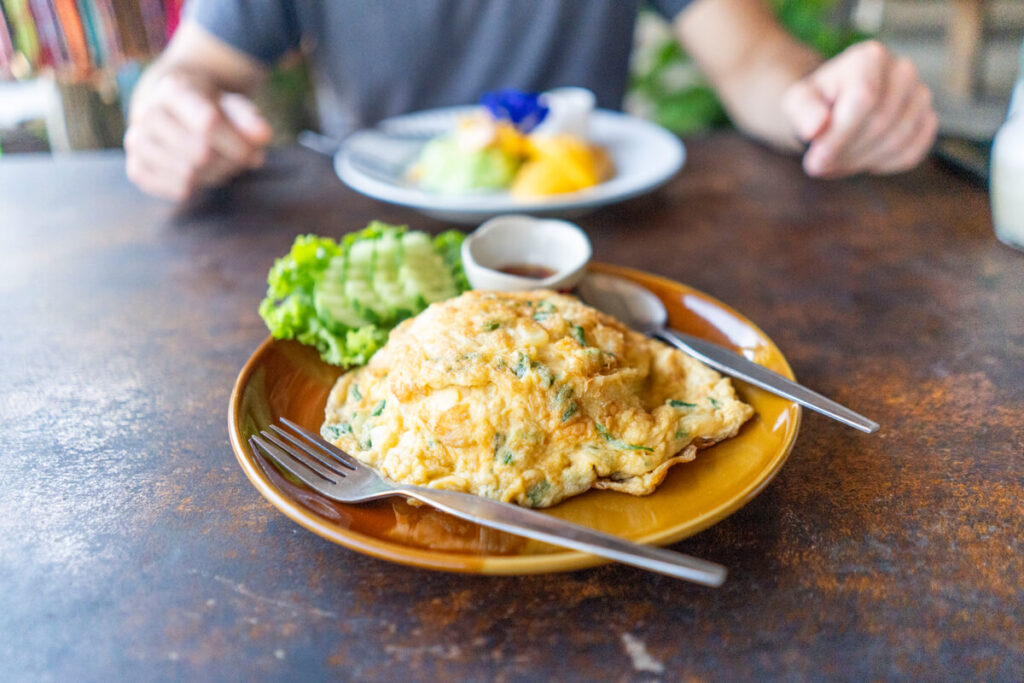
8. Satay Chicken
Marinated grilled chicken skewers, served with creamy peanut sauce and a small cucumber salad. Perfect as a snack or as a starter. We like to have a portion of rice and a cold Coke with it.
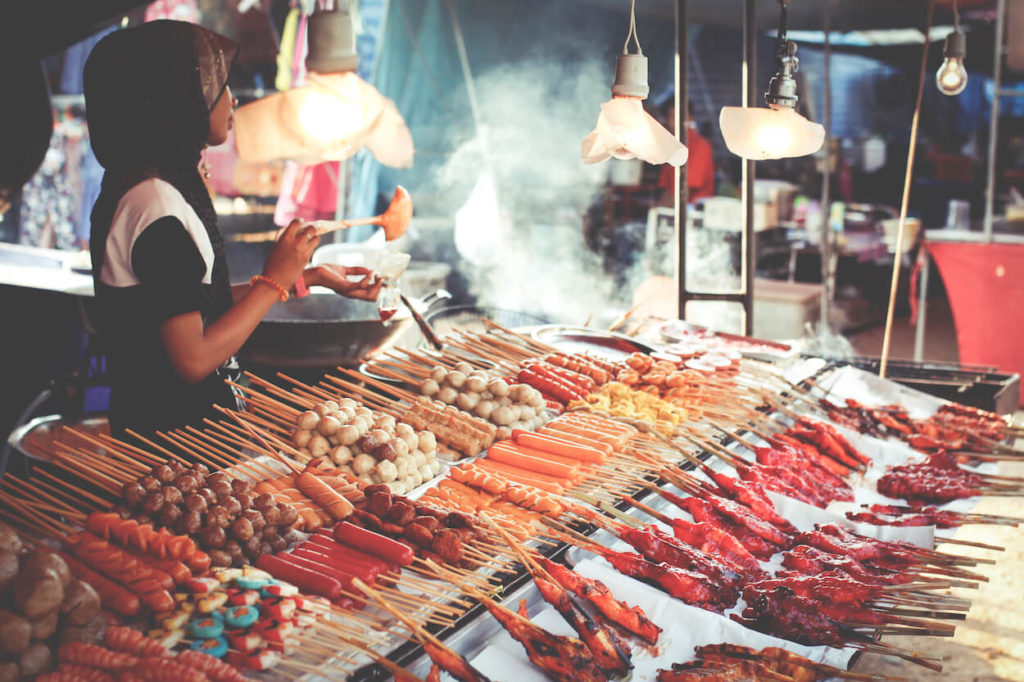
9. Spring Rolls (Popiah Tod)
Crispy, freshly fried spring rolls with a vegetable or meat filling, served with a sweet and sour sauce. A popular snack, especially at markets, that’s great to eat on the go. We actually order spring rolls as a small “starter” with almost every meal.
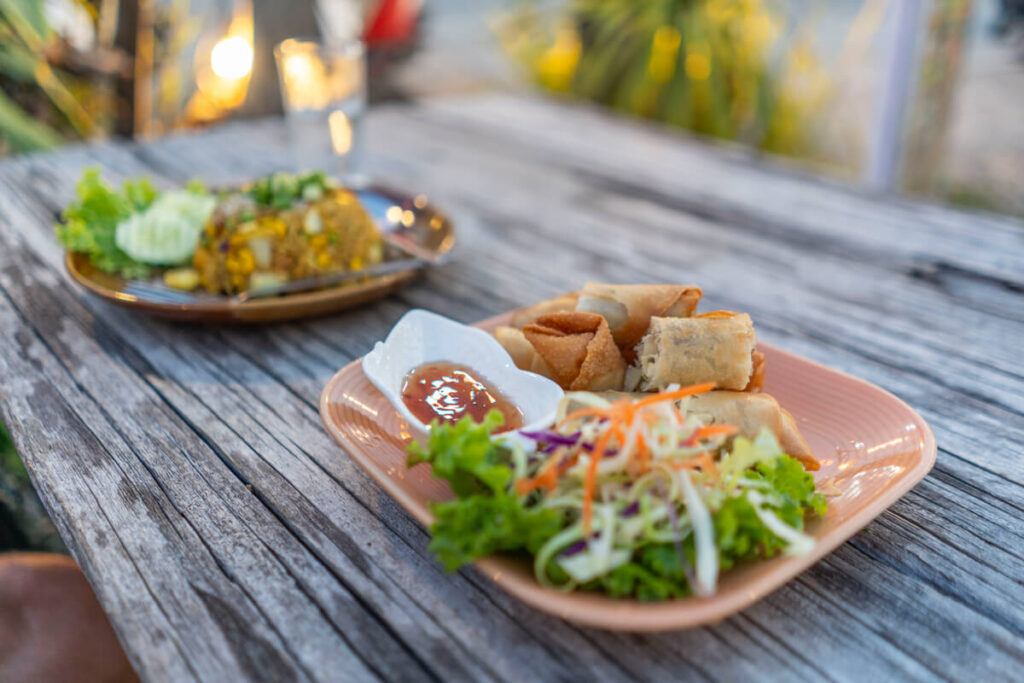
10. Fried Chicken with Cashew Nuts (Gai Med Ma Moung)
An absolute classic that we order again and again! Tenderly fried chicken, crunchy vegetables, roasted cashew nuts, and a slightly sweet, spicy sauce – with rice, and you’re in food heaven. Not too spicy, super flavorful, and always a good choice when you’re craving something savory. Especially delicious at night markets or in small Thai restaurants!

Dessert: Thai Pancakes (Roti)
To finish off your meal, you have to have something sweet! Thai pancakes (often called “roti”) can be found at almost every street food stall. The dough is rolled out wafer-thin, fried in plenty of oil until crispy, and then filled – traditionally with banana and chocolate.
But be careful: Some street food stalls really overdo it with the oil. The roti almost floats in the pan. It still tastes good, but at some point it becomes too greasy. Our tip: Watch how they prepare it beforehand – and if it’s too much for you, just ask for “little oil, please”!
Other delicious Thai dishes
- Khao Pad Goong (shrimp fried rice)
- Khao Pad Moo (pork fried rice)
- Khao Pad Nuea (beef fried rice)
- Morning Glory (water spinach)
- Tom Kha Gai (coconut chicken soup)
- Som Tam (papaya salad)
- Guay Teow (noodle soup)
- Pad Kana Moo Grob (Chinese fried cabbage with pork)
- Gai Yang (grilled chicken)
- Yam Woonsen (Glass noodle salad)
Street food in Thailand – what to look out for?
Street food is as much a part of Thailand as the beach is to the sea. On every corner, the aroma of fried noodles, freshly grilled skewers, and sweet pancakes fills the air. But of course, many people ask themselves – is it safe to eat? Our answer: Yes! If you pay attention to a few small things, you can try everything without worry.
What should you look out for?
- See where the locals eat! If lots of locals are queuing or sitting at a stall – jackpot! The food is fresh and good.
- Is everything freshly prepared? It’s best to only eat what’s prepared right in front of your eyes. It’s better to leave food that’s been sitting on display for ages.
- Hot is good! Fried, boiled, or deep-fried – anything served hot is generally safe. Be careful with lukewarm buffets or ready-made salads.
- Be careful with ice cubes and tap water. In tourist areas, clean industrial ice is usually used, but it’s better to ask or avoid it to be on the safe side. Bottled drinks or freshly squeezed juices without ice are always a better choice.
- Fruit and salads: Peeled fruit and freshly sliced mango are no problem. You should avoid raw salads, especially at very simple stalls.
Street food is not only delicious, but also a huge part of the culture. Go for it! The small food stalls in particular often offer the best food – and for little money.
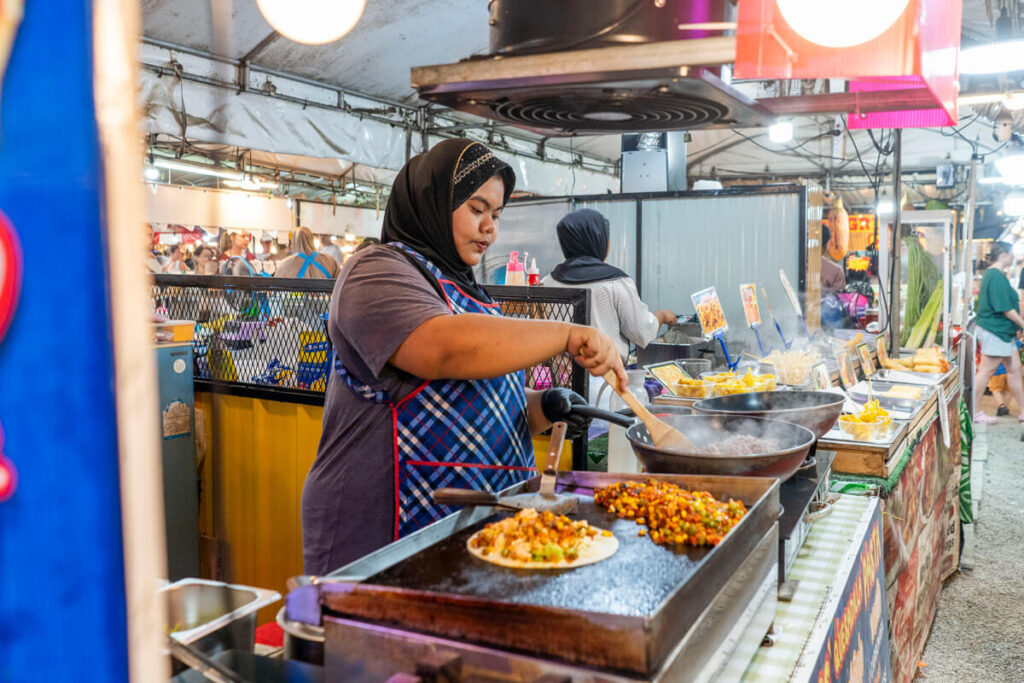
How spicy is “spicy” really?
If you think you can eat spicy food – wait until you get to Thailand! Thai “spicy” is in a completely different league than what we know from Europe. While “spicy” here often just means a pinch of chili powder, in Thailand it often means a mountain of fresh chilies that will make you break out in a sweat. Especially with curries or papaya salad (som tam), things can get really heated if you don’t say anything.
Our tip: If you can’t handle spicy food and prefer it milder, or just want a hint of spice, be sure to say “Mai phet” – which means “not spicy.” If you like a bit of spice but don’t want to escalate things, you can also say “phet nit noi” – which means “just a little spicy.” If things get too spicy, rice will help, not water! And if it’s really bad – wash it down with coconut milk, milk, or yogurt, if you can get it somewhere.
Typical drinks in Thailand
Of course, delicious food also requires something to drink. And Thailand has a lot to offer in that regard, too! Here are a few classics that you can find everywhere and that you should definitely try:
Thai Iced Tea (Cha Yen): Nice and sweet, strong, creamy, and ice-cold – black tea with condensed milk, sugar, and often a hint of vanilla. Super refreshing, especially in hot weather.
Fresh Coconut: Crack it open, insert a straw, and you’re done! Available on almost every corner, it’s perfect for a quick snack. The coconut provides both fluids and minerals.
Fresh Fruit Shakes: Whether mango, pineapple, papaya, or watermelon – freshly blended shakes with or without sugar. Make sure that ice cubes are only made from clean water (usually the case at larger stalls or restaurants).
Beer: The most well-known brands are Chang, Singha, and Leo. Chang is usually the cheapest and a bit stronger. Singha tastes a bit more bitter and is often sold as the “premium beer.”
Thai Rum (SangSom): If you want a little more in the evening, SangSom Rum with cola or soda is the classic. Cheap and quite strong.
Water: Sounds banal, but important: Only drink bottled water. Tap water is taboo.

Is there Western food?
Of course, there’s more to Thailand than just street food and food stalls. If you fancy something different, you’ll also find plenty of fancy restaurants, European cuisine, and Western classics. Depending on your destination, the selection is huge: In Bangkok, Phuket, Chiang Mai, or on Koh Samui, you can get not only burgers and pizza, but also Arabic, Indian, Italian, or American cuisine.
Especially in tourist hotspots, you’ll find a wide selection of restaurants. So don’t worry – even if you don’t feel like Thai food, you don’t have to starve. The prices there are of course higher than at a street stall, but they’re perfect if you’re looking for a change or are homesick for pasta or a good burger.
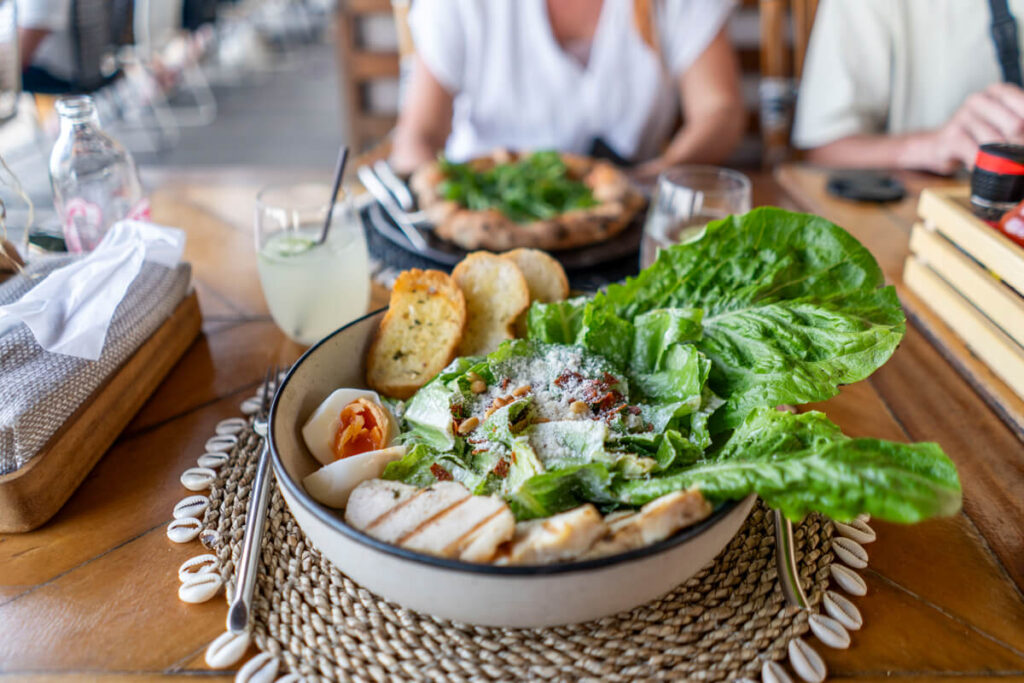

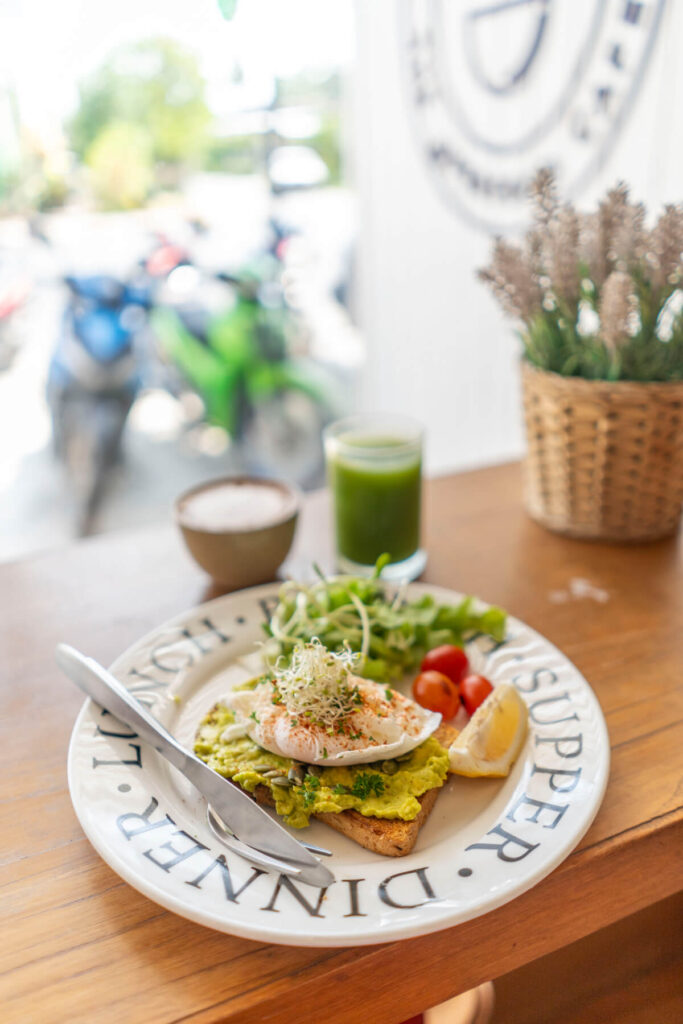
How much does food cost in Thailand?
Food in Thailand is not only incredibly delicious, but also super affordable. You can often find the best dishes at small street stalls or night markets – not only does it taste the most authentic there, but it also costs the least.
We were really surprised that you can still eat so cheaply in Thailand today. Ten years ago, a Pad Thai cost around 40 baht – and even now, you can still get one for 50 to 60 baht. You really can’t complain! And fresh shakes have also only become slightly more expensive.
- Street food (e.g. Pad Thai, fried rice, soup): 40 to 80 baht (approx. 1 to 2 €)
- Simple local restaurants: 80 to 150 baht (approx. 2 to 4 €) per dish
- Smoothies or fruit shakes: 40 to 60 baht (1 to 1.50 €)
- Fresh coconut: 40 to 50 baht (around 1 €)
- Thai iced tea: 30 to 50 baht (approx. 0.80 to 1.30 €)
- Beer (Chang or Singha, 0.6 l): 60 to 100 baht (1.50 to 2.50 €)
- Restaurant in tourist hotspots: 150 to 300 baht (8 to 15 €) per dish
Thai dishes for home
If you feel like recreating these delicious dishes at home after your trip to Thailand, it’s super easy! There are now really cool Thai cooking boxes that contain everything you need – from curry paste and coconut milk to the right spices.
Check out Konkrua – they have great sets for Pad Thai, curries, and more, all with instructions and super easy to make. You can also find various Thai cooking boxes on Amazon that are perfect for trying out. Bring the Thai feeling directly into your kitchen!
- Cooking Box | Pad Thai & Massaman Curry*
- Thai Curry Paste Box*
- Great cooking boxes from Konkrua